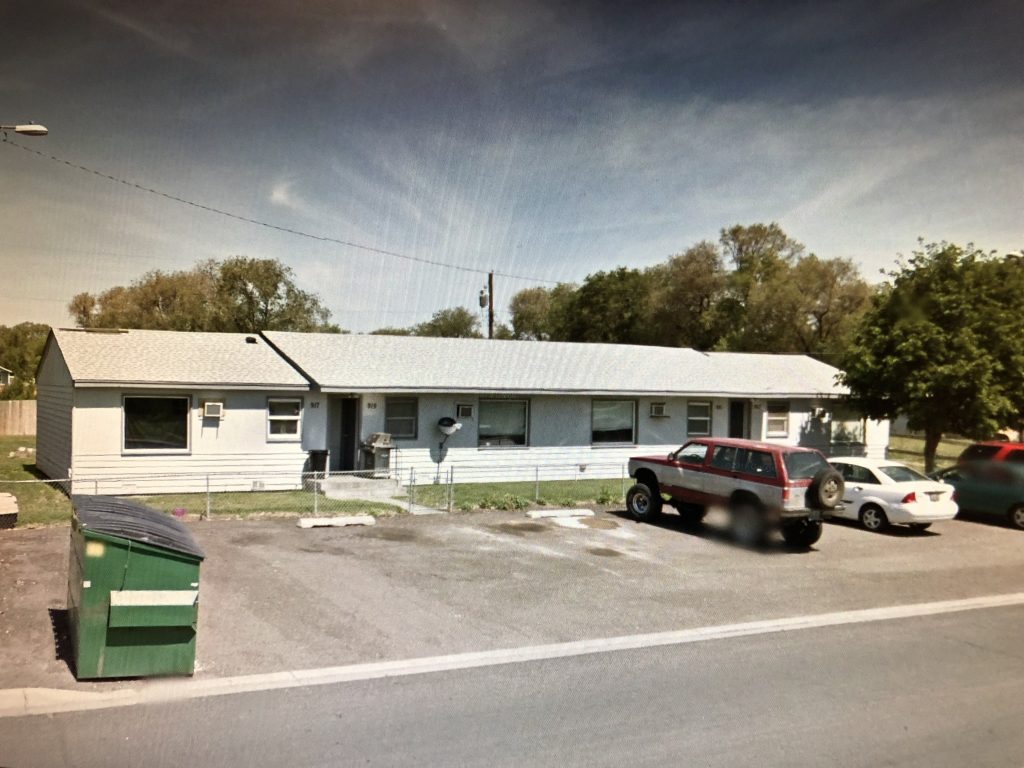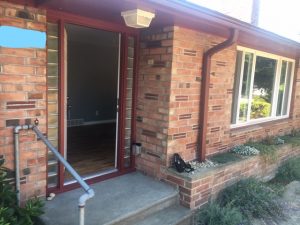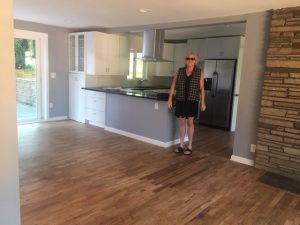Quick Facts:
- Profit Strategy: Buy, rehab & hold, AirBnB
- Number of Units: a duplex and a lakehouse
- Prior Experience: Some single family home flips, but no prior multifamily experience.

Lynn’s Call to Adventure
Like many people, Lynn worked in a field unrelated to her degree (psychology) and decided to work for FedEx. She loved the fast-paced environment and driving. She retired less than a month ago.
Lynn inherited her parent’s property, which is how she got into real estate investing. Before this, her financial situation was bleak.
Her parents passed away just three months apart. She was able to pay for her mom’s funeral cremation with money from her mom’s modest 401K. But when her dad died three months later, she didn’t know how she’d afford to finance his funeral. Her solution was to have a friend’s son move into the home and pay rent. She says it was strange because he had to live amongst all her dad’s belongings. She hadn’t even had time to clean. It was a situation of “help me, and I’ll help you.'”
The house was owned free and clear, but you inherit property taxes, utilities, insurance, and other expenses along with a home. She needed education on managing property immediately. She needed to learn how to manage cash flow.
She found the Fortune Builders mentorship program and started doing fix-and-flips because she loved the rehab process. She did her first one with her own money — got a loan, and then used her savings for the rehab and paid for contractors.
She experienced nightmares common to others with the unreliability and expense of contractors. But she completed that project and rolled into another one with a partner. But the partnership didn’t end well.
She decided to switch gears, acquire properties and pursue long-term renters. She already had a long-term renter in her parent’s house. Next, she purchased a property and turned it into an Airbnb.
COVID hit.
She continued quietly marketing the property for a couple of months. To her benefit, because it was in a rural area, people started renting it. As a result, the property did well during COVID.
She decided to pull money out of her parent’s house and use the money as a down payment for another lake home. She turned this into another Airbnb and bought a duplex simultaneously. The coordination of the financing didn’t happen quickly, so she borrowed private money for that down payment.
After refinancing the lakehouse, she paid back that private money loan. Her next project is to turn her parent’s home — on a beautiful lake as well — into an Airbnb. She loves sharing the experience of the great outdoors with vacationers.
Her Realization
Her reason for pursuing multifamily investing developed from learning that small apartments offered economies of scale. She realized having more units offsets a vacancy.
Her upcoming retirement led her once again to seek guidance and education. She is learning how to do multifamily investing with Lance’s training. Another exciting change unfolded from her mistakes and hurdles she’d already experienced — she had become skilled at remodeling properties without the aid of contractors.
Lynn’s Mission Unfolds
She got clarity on a mission she hadn’t previously developed: she could use multifamily investments to help others. Her first step was to join forces with the Salvation Army. “They have a program that assists people in rough situations — be it physical abuse, mental abuse, or victims of violence — reestablish their life.” So far, she’s been able to help two individuals and their kids restart life.
This program is similar to Section Eight, she explains. “They provide grants through the Salvation Army. They take an assessment of people’s financials. Then they help with the security deposit, the first month’s rent, and sometimes even the second month’s rent. In addition, they subsidize whatever is needed. It’s a one-to-two-year program.”
This organization offers other community-based programs that provide financial assistance, education, and support groups to help the participant transition into a better life.
She’s now considering purchasing a commercial building to turn it into a four-plex. That might become her next project. She anticipates using the same program. She reveals, “I’ve discovered this is what I need to be doing.”
While her financial goal is to earn $10,000/month in passive income, her dream extends far beyond this. “I want to help more people — not just myself and my family.” Sure, she wants to travel the world, but her bigger goal — her “why” — is to help families and animals in need. “I’ve always had a passion for animals. So that’s one of my significant driving forces — to set up a ranch to rescue animals.”
And she wants to influence people in other ways. “I’ve taught people the AirBnB model. I will be fixing a neighbor’s property so they can maintain it. I like providing knowledge and building others’ confidence to move forward.”
The Importance of Community
Building a community becomes vital to her, and it starts at home. “My wife and I joined fortune builders together. I got hurt at work which enabled us to accelerate quickly through the course. We had our first rehab in two months. I like to do the numbers, so I underwrite many of our deals. I find the private money. She is good at fix-and-flips. I feed her those deals and venture off independently to make more income and have a bigger impact.”
She recognized her goals would be achieved even faster by bringing in outside partners. “We have new partners down in Phoenix, Arizona. We started doing fix-and-flips there, and one of my partners also has a huge heart for helping people and animals. So perhaps I will form a partnership for that purpose.”
She marvels at how the partnerships in Phoenix sped up progress. “We’ve got one property rehabbed, and now we’re under contract to purchase the house next to it. Last night one of the partners brought me in another deal in Scottsdale. We’re also looking to purchase something in Georgia. Things are now moving quickly. Originally I had doubts, and I wanted to take things slow. But once that momentum starts, it just keeps going.”
Investing in real estate has changed her life in so many ways. “I’ve gotten healthier. In the last six months, I’ve lost 20 pounds, and I’m in a better relationship. We are meeting incredible friends. They are truly incredible people. We are forging relationships with people who have the same mindset. Before, I associated with less inspired people, and I wasn’t accomplishing things that were important to me.”
Her Advice
“Don’t do what I did, ‘analysis paralysis.’ I was afraid of making a mistake and not having the answers. I have learned that you learn by your mistakes. It’s okay to make mistakes. A body in motion stays in motion. If you’re sitting around, you’ll stay there.”
She muses, “I haven’t hit the big one yet, but many little wins add up. I keep plugging along and don’t give up. I think without the community, I may have given up. But the support of that group is so tremendous it has kept me propelling forward and not giving up.”
She suggests others surround themselves with like-minded people. “Build a community that will help you succeed and give you knowledge and confidence.”
“Get the education, but don’t get stuck in the minute details of it. Take action, and get a mentor. Enlist the support of partners and find an accountability partner. And never be afraid to reach out and ask for help.”
FIND. A. PARTNER. BUILD. A. COMMUNITY.







